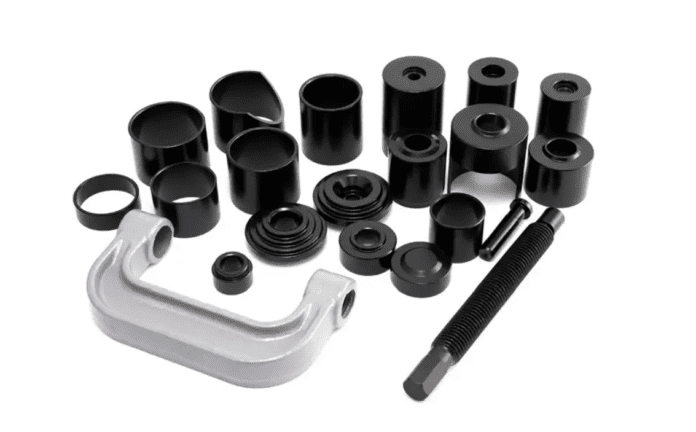Introduction
A ball joint press tool is an essential piece of equipment for mechanics and DIY car enthusiasts working on suspension systems. It allows for the removal and installation of ball joints without causing damage to the surrounding components. However, improper use can lead to injuries, tool damage, or costly vehicle repairs. To help you get the job done safely and efficiently, here are some of the most common mistakes to avoid when using a ball joint press tool.
- Not Wearing Proper Safety Gear
Working with suspension components requires caution, as ball joints are often under high pressure. Without proper safety gear, you risk serious injury.
What to Wear:
- Safety goggles to protect your eyes from flying debris.
- Mechanic gloves to improve grip and shield your hands from sharp edges.
- Protective clothing to prevent scrapes and bruises.
Neglecting safety gear can result in avoidable injuries, so always come prepared before handling a ball joint press.
- Incorrect Tool Selection
Not all ball joint press tools are created equal. Using the wrong size or type can make the job more difficult and increase the risk of damaging your vehicle’s suspension.
How to Choose the Right Tool:
- Check your vehicle’s make and model to ensure compatibility.
- Use the correct adapter set for the ball joint size.
- Invest in a quality press kit that can handle high-pressure applications.
Using an ill-fitting tool can lead to misalignment, making removal or installation harder than necessary.
- Failing to Secure the Vehicle Properly
A poorly supported vehicle can shift unexpectedly, causing serious injury. This mistake is especially dangerous when using high-force tools like a ball joint press.
Safe Setup Practices:
- Always use jack stands, never rely solely on a hydraulic jack.
- Ensure the vehicle is on a level surface to prevent tilting.
- Engage the parking brake and use wheel chocks for extra stability.
Taking the time to secure your workspace can prevent accidents and damage to your vehicle.
- Not Applying Enough Lubrication
Ball joints can be difficult to remove, especially if they are rusted or seized. Skipping lubrication forces you to use excessive pressure, increasing the chance of breaking the tool or damaging the suspension components.
Proper Lubrication Tips:
- Use penetrating oil (such as WD-40 or PB Blaster) on the ball joint before pressing it out.
- Apply grease when installing the new joint to reduce friction.
- Let the lubricant sit for a few minutes before attempting removal.
Proper lubrication makes the process smoother and reduces wear on both the tool and vehicle components.
- Misalignment of the Press Tool
Aligning the press tool incorrectly is one of the most common mistakes when working with ball joints. A misaligned tool can bend or crack components, leading to costly repairs.
How to Ensure Proper Alignment:
- Double-check that the press cups are centered over the ball joint.
- Make sure the receiving cup is aligned with the joint to avoid side pressure.
- Avoid forcing the tool—if it doesn’t move smoothly, realign and try again.
Misalignment often results in an ineffective press, causing frustration and potential damage.
- Applying Excessive Force
While ball joints require a fair amount of pressure for removal, applying too much force can break the press tool or damage the suspension.
How to Avoid This Mistake:
- Apply pressure gradually instead of forcing the tool.
- If resistance is too high, double-check alignment and use more lubrication.
- Avoid using a cheater bar on the press handle, as this can lead to excessive force.
If you find yourself struggling, stop and reassess before applying more pressure.
- Ignoring Manufacturer Instructions
Every vehicle has specific ball joint removal and installation procedures. Skipping the manufacturer’s instructions can lead to improper installation, affecting vehicle performance.
Key Guidelines to Follow:
- Refer to the vehicle’s service manual for correct torque specs and installation steps.
- Follow the tool manufacturer’s recommendations for safe use.
- Use OEM-recommended ball joints to ensure proper fit and durability.
Cutting corners may seem like a time-saver, but it can result in premature ball joint failure.
- Skipping Inspection of Ball Joints and Components
When replacing ball joints, it’s essential to inspect surrounding components, such as control arms and bushings. Installing a new ball joint into a worn-out control arm can lead to premature failure.
What to Check Before Installation:
- Look for cracks or rust in the control arms.
- Check for excessive wear on bushings and replace if necessary.
- Ensure proper fitment before pressing in the new ball joint.
A thorough inspection can help prevent the need for additional repairs down the line.
- Rushing the Process
One of the biggest mistakes mechanics make is rushing through the ball joint replacement. Taking shortcuts can result in misalignment, improper installation, or damage to vehicle components.
How to Avoid This Mistake:
- Take your time to align the tool properly before pressing.
- Follow each step carefully, without skipping instructions.
- Double-check torque specs and final assembly before driving the vehicle.
Patience is key to a successful and safe ball joint replacement.
- Improper Reassembly and Torqueing
Reinstalling suspension components incorrectly can lead to handling issues and safety risks. Improper torqueing is a common problem that can affect the longevity of your ball joints.
Reassembly Best Practices:
- Tighten bolts and nuts to the recommended torque specifications.
- Use a torque wrench to ensure accuracy.
- Double-check all fasteners before lowering the vehicle.
Over-tightening can stress the components, while under-tightening can lead to joint movement and failure.
Conclusion
Using a ball joint press tool correctly is essential for a smooth and safe repair process. By avoiding these common mistakes—such as improper alignment, excessive force, and skipping safety precautions—you can prevent costly errors and ensure the longevity of your vehicle’s suspension.
Always take your time, follow manufacturer guidelines, and use the right tools for the job. Whether you’re a seasoned mechanic or a DIY enthusiast, these tips will help you complete the job efficiently and safely. For reliable performance and durability, consider using Orion Motor Tech ball joint tools, which are designed for precision and ease of use.










